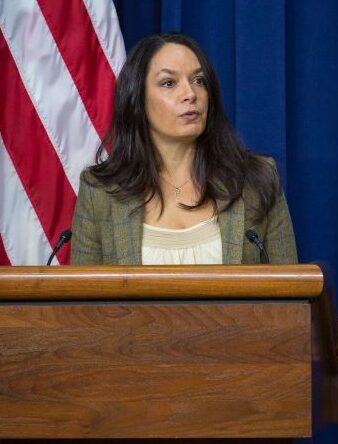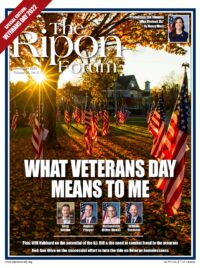
Each Veterans Day, we commemorate U.S. Military veterans for their service to this nation. However, truly honoring our veterans demands so much more than one day of parades and proclamations. Honoring our veterans means ensuring that every person who has served in the military can live a safe and secure life after they’ve completed their service.
Their needs are many: health care, disability compensation, employment, and job training often top the list. But the single most important thing that every veteran needs is a safe and affordable place to live.
Unfortunately, our nation has not always lived up to this need. In fact, the United States had shockingly high rates of veteran homelessness for decades. As recently as 2010, there were at least 74,000 veterans experiencing homelessness on a given night.
This was – to put it lightly – a national disgrace. And so, in 2010, the federal government and communities across the country prioritized ending veteran homelessness. Ultimately, this effort became the essential proof point in what was possible for ending homelessness for all Americans: between 2010 and 2019, the number of homeless veterans was cut in half, outpacing progress for every other subpopulation of people experiencing homelessness.
Between 2010 and 2019, the number of homeless veterans was cut in half, outpacing progress for every other subpopulation of people experiencing homelessness.
It was one of the great honors of my time at the U.S. Department of Housing and Urban Development to be part of the team that undertook this work. And so, as we commemorate Veterans Day 2022, I’d like to reflect on the three factors that made progress possible: leadership, resources, and strategy.
Leadership
Leadership is essential to meeting any objective. Leadership brings clarity to difficult decisions. It unifies purpose and activity among those on the front lines. And it marshals the resources needed to accomplish our goals.
Sustained reductions in veteran homelessness were made possible because of the broad alignment of federal, state, county, and city leaders who brought unity, urgency, and public will to this goal – a commitment that started from the very highest levels of government.
The impact of that kind of unified purpose represents government at its finest. Unified leadership reduced obstacles to our goals, motivated and encouraged frontline providers, and ultimately accelerated progress for veterans who needed help.
Resources
Every mission requires appropriate resources. The consequences of not having them can be catastrophic.
Those on the front lines of ending homelessness know this too well. Every day, homeless system leaders and frontline workers do life-saving work, despite a dire shortage of the federal funds needed to bring their programs to scale.
The one exception, however, has been for veterans. When the federal government prioritized veteran homelessness, Congress followed up with unprecedented bipartisan appropriations to help communities do the work. Between 2010 and 2017, the federal government more than doubled federal funding for homeless veteran programs.
This commitment was a game changer. No other subpopulation of people experiencing homelessness has ever benefitted from this kind of resourcing. And so it should not be a surprise that no other subpopulation has ever experienced the kinds of reductions that veterans have.
Strategy
Of course, leadership and resources mean little without an effective strategy.
In the case of ending veteran homelessness, this meant relying on good policy. It meant a laser focus on results, rather than optics or politics. It meant ignoring assumptions about who might or might not succeed, or judgments about who did or did not deserve help.
Instead, the strategy was entirely driven by data that demonstrated which approaches helped the most people get off the street and into permanent housing.
That approach was Housing First.
There is currently widespread confusion as to what Housing First is and isn’t. But during the push to end veteran homelessness, there was no question: Housing First simply means that people who are homeless need to be reconnected to a home as quickly as possible, without onerous preconditions. The services people may need – like healthcare, mental health treatment, drug treatment, or job training – all work better if a person first has a stable place to call home.
When veteran homelessness programs started operating under a Housing First model, the outcomes were undeniable: they dramatically reduced the waiting times to connect veterans with permanent housing, improved retention rates in housing, and stabilized more veterans once they were housed.
These are unassailable benchmarks for determining success.
The Path Forward
Despite this progress, the news is not all good. Homelessness has been on the rise across the nation for the past few years, and progress on veteran homelessness has plateaued. Veterans of color continue to have the highest likelihood of experiencing homelessness. And the most recently available federal data shows that between 2019 and 2020, there was a six percent increase in unsheltered homelessness among veterans. We can’t have that.
Despite this progress, the news is not all good … the most recently available federal data shows that between 2019 and 2020, there was a six percent increase in unsheltered homelessness among veterans.
The primary driver for these increases is our nationwide affordable housing crisis. More and more people – including countless U.S. Military veterans – simply cannot afford to stay in their homes. Headlines on rent-gouging and inflation have brought this issue to the forefront in the past year, but for those with the lowest incomes this is nothing new. It is simply getting worse.
In the face of these headwinds, we must do more. That starts by re-committing to the federal strategies and programs that have ended homelessness for tens of thousands of veterans. It then requires us to increase funding for these programs so that they can continue to serve the growing number of veterans who need them.
To accomplish that, we will all need to come together – because ending veteran homelessness has never been a partisan issue in the past, and it should not be one today. United States Military veterans deserve safe and dignified places to live, and I firmly believe that this is something every single lawmaker can support.
That is what keeps me inspired and motivated this Veterans Day. Ending veteran homelessness would be a true tribute to our nation’s veterans. And I believe it is the kind of victory our nation needs at this moment.
The good news is that we know how to do it. We know the strategies and programs that work. We know the resources we need. And we know that this is a truly bipartisan opportunity for our leaders to embrace.
Our nation’s veterans answered the call. Now it’s our turn.
Ann Oliva is CEO of the National Alliance to End Homelessness, a public education, advocacy, and capacity building organization dedicated to ending homelessness in the United States.




